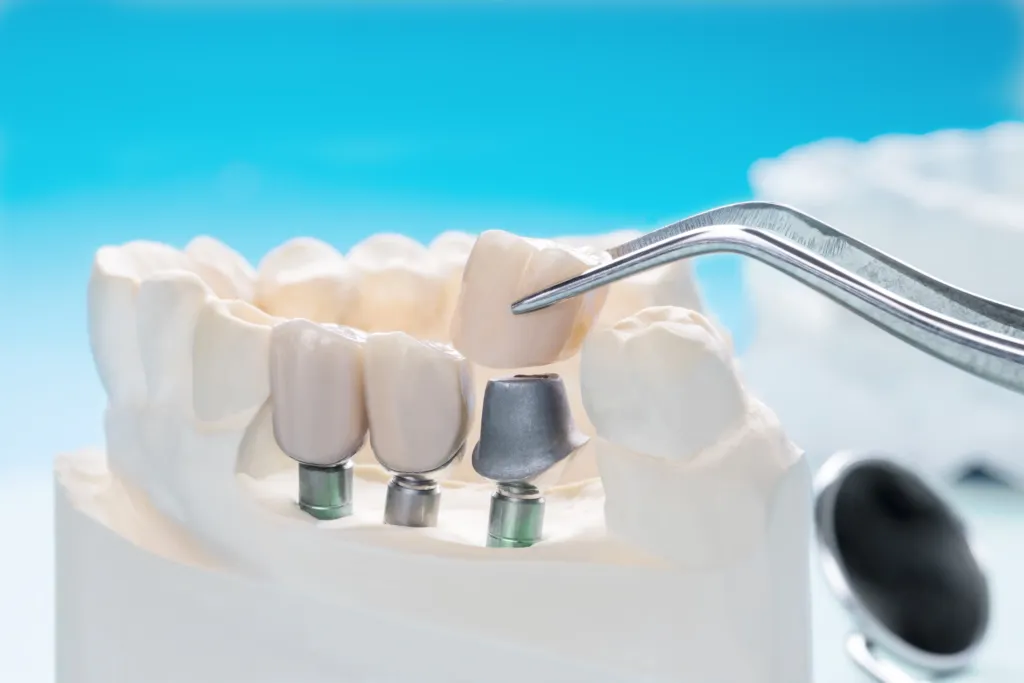TEDAVİLERİMİZ
İmplant Tedavisi

İmplant Tedavisi Nedir?
İmplant tedavisi, eksik dişlerin yerine çene kemiğine titanyumdan üretilmiş yapay kökler yerleştirilerek uygulanan modern bir diş hekimliği yöntemidir. Bu yapay köklerin üzerine yerleştirilen protez dişler, hem estetik görünümü hem de çiğneme fonksiyonunu doğal dişlere en yakın şekilde geri kazandırır.
Aile Diş Polikliniği olarak, Sancaktepe ve Kartal şubelerimizde implant tedavisini dijital görüntüleme, 3D planlama ve yüksek sterilizasyon standartları ile uyguluyoruz. Tedavilerimiz, Başhekim Dt. Kerem Özgüler liderliğinde, alanında uzman diş hekimlerimiz tarafından kişiye özel olarak planlanır.
İmplant Tedavisi Hangi Durumlarda Uygulanır?
İmplantlar, tek diş eksikliğinden tam dişsizlik durumuna kadar pek çok senaryoda kullanılabilir.
Aşağıda, implant tedavisinin en sık tercih edildiği durumlar yer almaktadır:
Tek diş eksikliklerinde, komşu dişlere zarar vermeden boşluğun kapatılması
Uzun dişsiz boşluklarda köprü protezlerin desteklenmesi
Tüm dişlerin eksik olduğu durumlarda sabit protez desteği sağlanması
Çene kemiği erimesi nedeniyle protez tutuculuğunun azaldığı vakalar
All-on-4 ve All-on-6 gibi tam dişsizlik çözümleri
Uzm. Dt. Hatice Erkin’in Görüşü:
“İmplant tedavisinin başarısı, doğru endikasyon ve iyi planlama ile başlar. Her hastanın kemik yoğunluğu, genel sağlık durumu ve estetik beklentisi farklıdır. Bu yüzden her tedavi kişiye özel planlanmalıdır.”
İmplant Tedavisinden Önce Nelere Dikkat Edilmeli?
Kemik yapısı değerlendirilmelidir: CBCT (Konik Işınlı Bilgisayarlı Tomografi) ile kemik hacmi ölçülür.
Diş eti sağlığı korunmalıdır: Tedavi öncesinde diş eti hastalıkları varsa giderilmelidir.
Genel sağlık durumu önemlidir: Kontrolsüz diyabet, kan pıhtılaşma bozuklukları gibi durumlar tedaviyi etkileyebilir.
Sigara kullanımı sınırlandırılmalıdır: İyileşme sürecinde sigara implant başarısını azaltır.
İmplant Tedavisi Nasıl Uygulanır?
Aile Diş’te implant tedavisi 5 ana aşamada ilerler:
| Aşama | Açıklama |
|---|---|
| 1. Muayene ve Planlama | Ağız ve çene yapısı incelenir, radyolojik görüntüleme yapılır. |
| 2. Çene Kemiği Hazırlığı | Gerekirse kemik grefti veya sinüs lifting işlemleri yapılır. |
| 3. İmplant Yerleştirme | Lokal anestezi altında titanyum vida çene kemiğine yerleştirilir. |
| 4. İyileşme Süreci | 2–6 ay arasında implantın kemikle kaynaşması beklenir. |
| 5. Protez Takılması | İmplantın üzerine porselen veya zirkonyum kaplama yerleştirilir. |
Dt. Kerem Özgüler (başhekim) Yorumu:
“Cerrahi sırasında hastanın konforu bizim için önceliklidir. Lokal anestezi ile işlem ağrısızdır ve iyileşme sürecinde düzenli kontrollerle süreci yakından takip ederiz.”
İmplant Çeşitleri ve Kaplama Seçenekleri
Tek diş implantı – Sadece bir diş eksikliği için uygulanır.
Çoklu implant – Birden fazla diş boşluğunu kapatmak için.
All-on-4 / All-on-6 – Tam dişsizlikte sabit protez çözümü.
Hızlı implant – Diş çekimi ve implantın aynı gün yapılması.
Kaplama seçenekleri:
Porselen kaplama – Doğal diş görünümüne en yakın.
Zirkonyum kaplama – Yüksek dayanıklılık ve estetik.
Metal destekli porselen – Arka dişlerde dayanıklılık için.
İmplant Sonrası Dikkat Edilmesi Gerekenler
Günde en az 2 kez diş fırçalama
Diş ipi, arayüz fırçası ve ağız duşu kullanımı
Sigara ve alkol tüketimini sınırlama
Sert gıdalardan kaçınma
Düzenli hekim kontrollerine gitme
Uzm. Dt. Hatice Erkin Tavsiyesi:
“İmplant tedavisinin uzun ömürlü olması, büyük oranda hastanın ağız hijyenine gösterdiği özenle ilgilidir. Tedavi sonrası bakım, tedavinin bir parçasıdır.”
İmplant Tedavisinin Avantajları
Doğal diş görünümü ve hissi
Çiğneme fonksiyonunun geri kazanılması
Kemik erimesinin önlenmesi
Komşu dişlere zarar verilmemesi
Uzun ömürlü ve güvenilir çözüm
Hizmetlerimiz
İletişime Geç
Güçlü Bir Gelecek, Sağlıklı Gülüşlerle Başlar
Merkez Şube
Uğur Mumcu Şube
Yakacık Şube
SIKÇA SORULAN SORULAR
İmplant Tedavisi
01 İmplant tedavisi ağrılı bir işlem midir?
Hayır. İmplant operasyonu, etkili bir lokal anestezi altında yapıldığı için işlem sırasında kesinlikle ağrı hissedilmez. Operasyon sonrası oluşabilecek hafif sızı veya şişlik, normal bir diş çekimi sonrası yaşanan rahatsızlıktan farksızdır ve hekiminizin reçete edeceği ağrı kesicilerle kolayca kontrol altına alınır. Hastalarımızın çoğu, işlem sonrası süreci beklediklerinden çok daha konforlu geçirdiklerini belirtmektedir.
02 Herkes implant yaptırabilir mi? Kimler için uygundur?
Genel sağlık durumu iyi olan ve implantı destekleyecek yeterli çene kemiği bulunan her yetişkin birey implant tedavisi için uygun bir adaydır. Kemik miktarının yetersiz olduğu durumlarda ise "kemik tozu (greft) uygulaması" veya "sinüs lifting" gibi ileri cerrahi tekniklerle kemik hacmi artırılarak implant uygulaması mümkün hale getirilebilir. Kontrol altında olmayan diyabet veya ciddi kalp rahatsızlıkları gibi durumlarda ise doktor onayı gerekebilir. En doğru kararı, muayeneniz sonrası hekiminiz verecektir.
03 İmplant fiyatları 2025 yılında ne kadar? Fiyat neye göre değişir?
İmplant tedavisi fiyatları; kullanılan implantın markası ve kalitesi, üzerine yapılacak olan protezin (kaplamanın) materyali (zirkonyum veya metal destekli porselen), kemik tozu gibi ek cerrahi işlemlere ihtiyaç duyulup duyulmadığı ve yapılacak implant sayısına göre değişiklik gösterir. Bu nedenle net bir fiyat vermek yanıltıcı olabilir. Aile Diş Polikliniği'nde ilk muayeneniz sonrası, size özel tedavi planınız ve tüm detayları içeren şeffaf bir fiyatlandırma sunulur.
